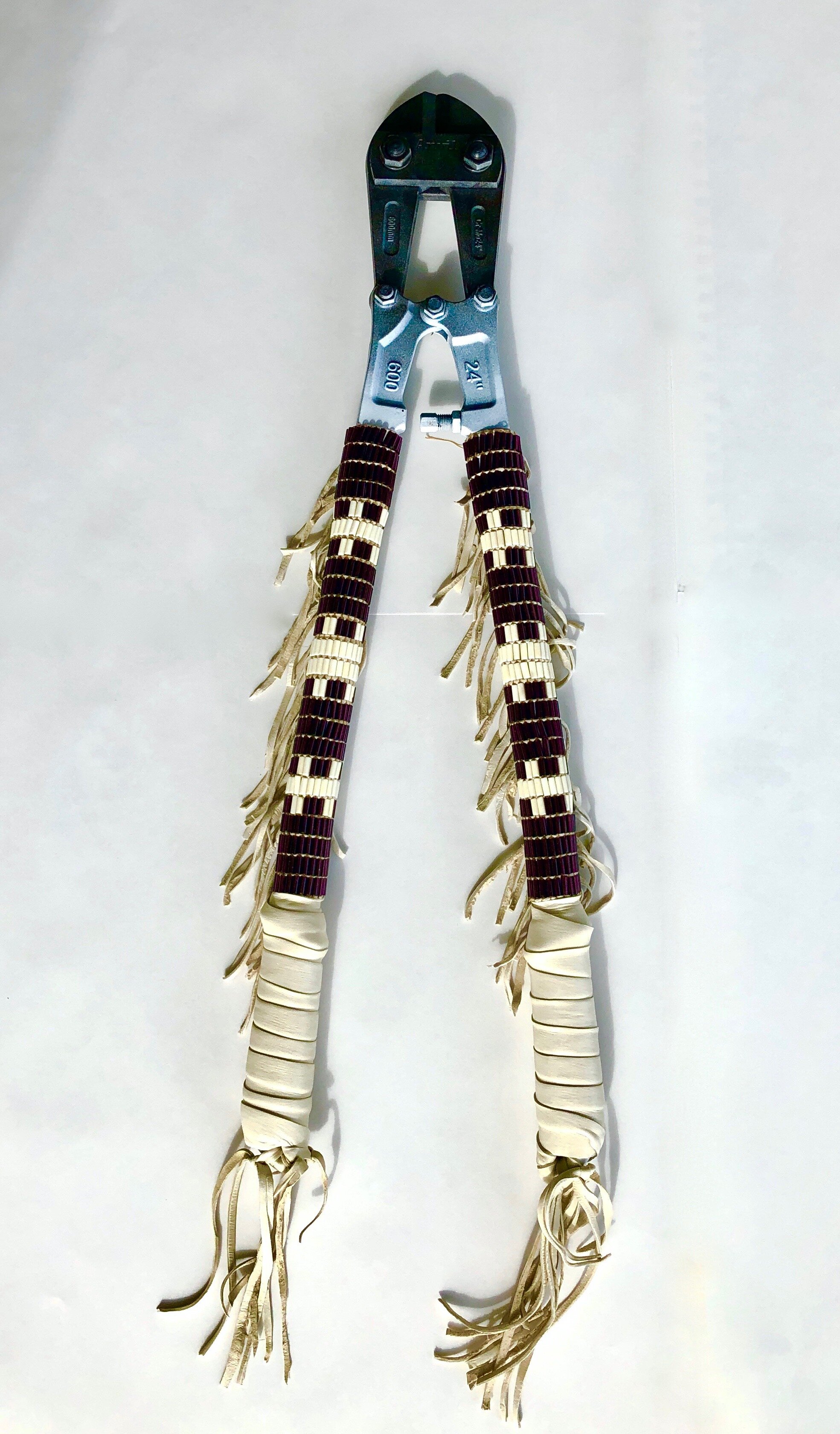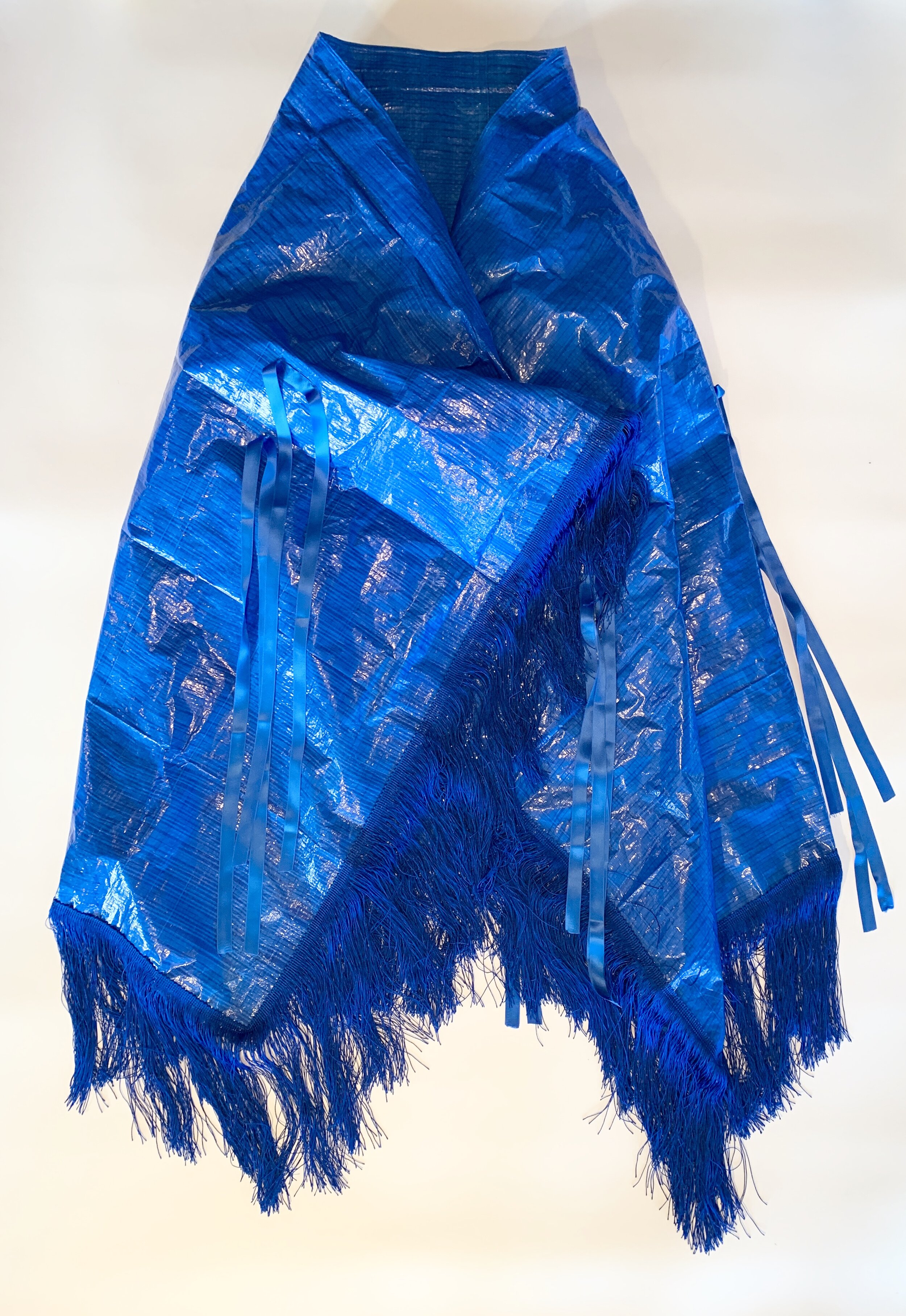Merritt Johnson was born in West Baltimore and spent her childhood navigating between trees, tarps and concrete. For two decades, Johnson’s work has navigated the spaces between bodies and the body politic, land and cultures by making images and objects as points of intersection. The artist's multiplicity is embodied in the materials and processes she employs to create layered works asserting allegiance and agency in the face of continued threats to land, water, culture, and bodies. Her works are containers for story, feeling and thought. Johnson earned her BFA from Carnegie Mellon University and her MFA from Massachusetts College of Art and Design. She is represented by Accola Griefen Fine Art in New York.
For more information, please see: Merritt’s website, Accola Griefen Fine Art, and on Instagram @me.rritt.
Merritt Johnson, Necessity Channeling Creation, 2020. Handwoven reed and black ash, fabric, tarp, fringe, resin, metal leaf, sweet grass. Image courtesy of the artist.
First, and most importantly, how are you doing? How are you navigating the highs and lows?
I’m healthy and able to be with my partner and children right now, and we have a safe and comfortable space to live and work, and we have secure sources of food and clean water, so I’m very grateful for all of that. The highs and lows keep moving, and right now many persistent realities of oppression and injustice are being highlighted broadly and the increased awareness of the world we live in has the capacity to intensify the highs and lows that were already present. The addition of new challenges due to Covid19 has impacted me; two of my children continue to live in NYC during the school year, and so my ability to be with them during that part of the year has been limited. I work on staying grounded by working in the studio, spending time outside, walking or running in the forest, or being out on the water, and practicing gratitude.
It's my experience that most artists engage with some level of self-isolation in their day to day art practice. Has this been your experience? And if so, have you found these innate rhythms to be helpful during this larger, world-wide experience of isolation?
I’m very fortunate to be married to another artist (Nicholas Galanin), so we get to work together. We sometimes collaborate, but we get to support each other in talking about work, and in making it, so I don’t feel at all isolated in that way. While not traveling for work has been unfortunate in some ways, it’s been a gift that we’ve been able to spend so much time at home together, with each other, and with our kids.
Merritt Johnson, Love Song, 2020. Handwoven palm fiber and stethoscope. Image courtesy of the artist.
It would be great if you could briefly talk us through your practice. Understanding it is integral to appreciating the multivalence of your work.
I’m not sure I can accurately talk through it because it’s something I do without talking until later. I feel through ideas and think through them, and then making the work for me is a really important continuation of thinking and feeling through the ideas manually or physically in some way. My video works are the most engaged with speaking and talking through things verbally. In some ways I feel like the work I do is all the same, it’s all connected and interwoven, and the different forms and processes are driven by necessity of what I have access to in terms of time or space or resources (material and/or financial). The ideas also speak differently through material or process, and they speak to different people differently, they are not all equally accessible. Certain vocabularies are contained in certain materials, and they tell stories in different ways, so I try to listen and consider what materials carry and if I can learn their language, and speak with them in good ways.
Has any of your imagery shifted in a reflection to what's currently happening? And why, or why not?
I don’t think so, and it’s also maybe too soon to tell. I don’t see the world as suddenly different, I see the world as being in sharper focus, and that focus is bringing things into view for many people for different reasons.
Merritt Johnson, Forest Seed Basket for Present and Future Understanding, 2019. Handwoven black ash, wood. Image courtesy of the artist.
Are you thinking differently? Coping differently? Inspired differently?
My awareness of distance is heightened when I’m not with all my children. I'm thinking about the things I'm always thinking about. Right now, it seems like there is more receptiveness to some of those thoughts and ideas; more support for dismantling systemic and institutional racism and defunding militarized police and ending the police state, and working to build an equitable world based on Indigenous led land sovereignty. And I'm thinking about how much support isn't happening: how much is being ignored still, ICE facilities and militarized borders weaponized against Indigenous peoples, countless acts of violence against BIPOC and especially transgender POC; about women and children trapped in dangerous and abusive homes right now, and about how many people are showing up to defend monuments to racism, genocide and enslavement. I don't know how lasting this spreading engagement will be; we still have a very long way to go, and so much listening and teaching and learning to do to combat willful ignorance of not only contemporary realities but also of our histories. So I think about it as a multigenerational marathon, that I have to work as long as I'm here, to do my work and also to prepare my kids to do theirs.
Merritt Johnson, Prayer Mask (contemporary), 2017. Handwoven palm fiber and chemical respirator. Image courtesy of the artist.
What is bringing you solace, or even joy, in this moment?
The same things that did before: my family and friends, especially my partner and children. The work I do, the knowledge that we can work to be better and do better despite whatever we have endured or been subjected to and whatever we have subjected others to. We’re all capable of causing damage and pain, and we’re all capable of creating and building equity, healing, strength, resilience, and love.
Merritt Johnson, Border Wampum, 2019. Glass wampum, deerskin, bolt cutters. Image courtesy of the artist.
What research or writing are you doing that you find compelling?
I just finished writing a script for a new Exorcising America video on conditioning.
Are you reading anything?
I just finished reading Brutal Imagination by Cornelius Eady and just started reading Beyond Settler Time: Temporal Sovereignty and Indigenous Self Determination by Mark Rifkin. Both are great.
Merritt Johnson, Fancy Shawl for the Frontlines, 2020. Tarp, ribbon and fringe. Image courtesy of the artist.






